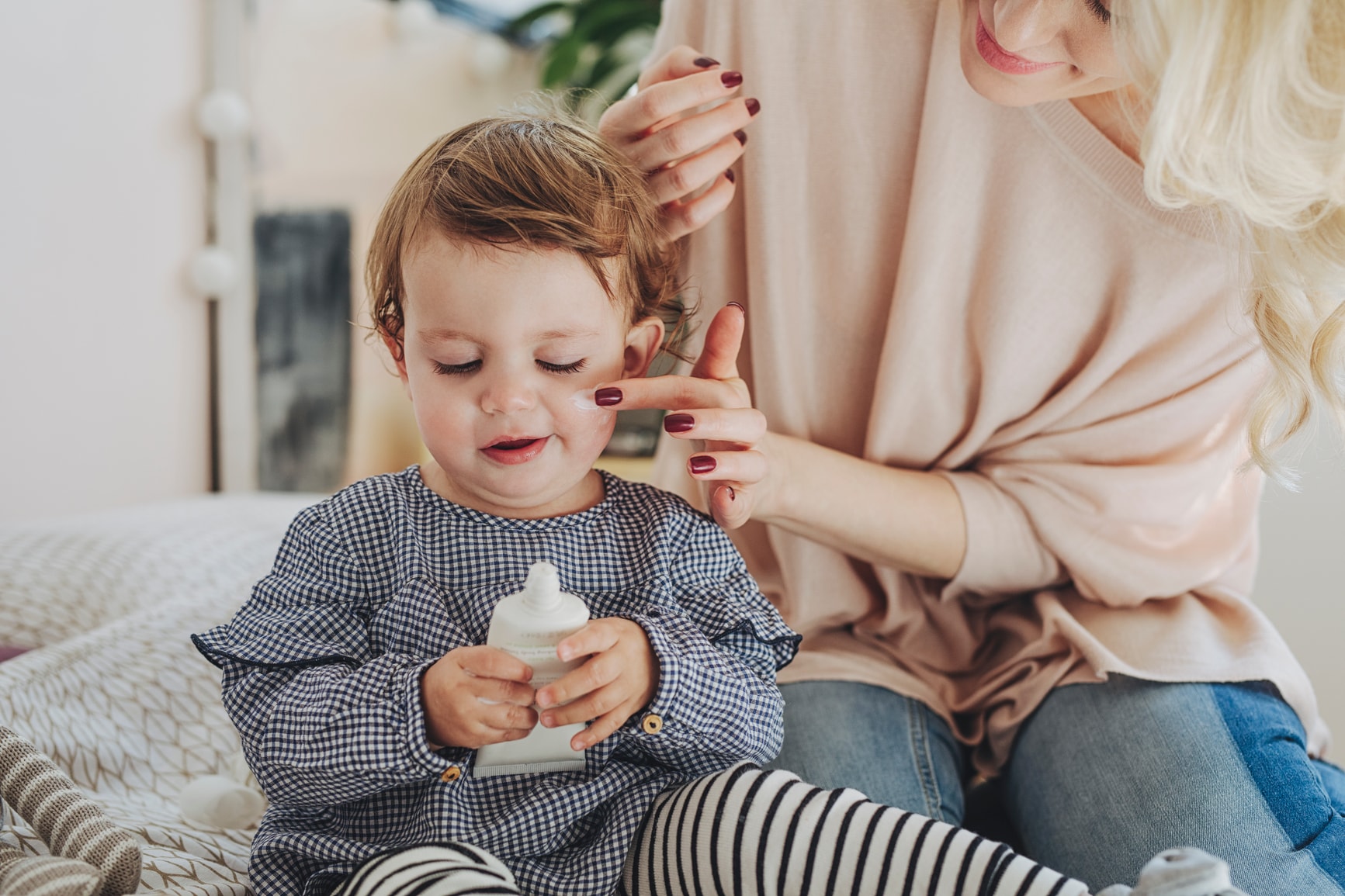Eczema (atopic dermatitis) is a common condition found in children, and can occur at any age. Several dermatological treatments exist for atopic dermatitis but, as of yet, there are no known cures. Patches of dry, itchy skin characterize the condition. Depending on the severity of symptoms, it can lead to difficulties concentrating in school and getting a restful night’s sleep.
Clinical trials are in progress to improve pediatric eczema treatment to lessen symptoms and provide relief. Eczema cream for kids is designed to prevent flare-ups and mitigate symptoms when flare-ups do occur. While most children grow out of eczema, it can persist into adulthood. So what can parents do now to make living with eczema easier for children?
What is Eczema?
Current studies estimate that 10% of Americans live with eczema, but the number could be higher due to sufferers not seeking treatment.
No cure has been found for the condition, but existing eczema products for toddlers and older children have presented encouraging results. Some parents may opt for a children’s eczema natural treatment, such as by avoiding certain hygiene products and regular moisturizing.
Some parents may have difficulty telling the difference between eczema and a simple childhood rash. It can lead to parents opting for over-the-counter (OTC) rash cream for kids rather than opting for a comprehensive prescription toddler eczema treatment.
But how do you know if your child is suffering from eczema? Here are the primary symptoms of atopic dermatitis:
- Dry skin
- Itching of varying severities
- Red or brownish-gray skin patches
- Bumps leaking fluid and forming a crust
- Thick, scaly, or cracked skin
- Raw, sensitive skin
Eczema can appear anywhere on the body, but the hands, ankles, feet, wrists, neck, chest, and eyelids are most common. Toddlers may also have eczema on the face and scalp. Flexural areas, such as the elbow and knees, are also problematic areas for those suffering from eczema.
Eczema Symptoms by Age
Eczema symptoms are not consistent by age. The signs and symptoms of atopic dermatitis vary based on the child’s age, making it difficult to recognize. Furthermore, children within different age groups will generally see patches varying in appearance and location.
Infants (First Six Months)
Infants can develop the condition anywhere on their body, but are more likely to experience atopic dermatitis on the face, cheeks, chin, scalp, and forehead. While it may spread to other areas of the body, eczema is rarely found in an infant’s diaper area. The moisture is responsible for protecting the skin here. Eczema in infants tends to display more redness and is more likely to weep.
Babies (6-12 Months)
Babies between six and twelve months old suffering from eczema are more likely to experience patches on the elbows and knees. These areas are more likely to be scratched or rubbed while learning to crawl. Due to infection, small bumps on the skin and patches with a yellow-tinted crust are common.
Toddlers (2-5 Years)
Children are more likely to experience facial eczema than adults. Toddlers around the age of two often experience itchy patches on the wrists, hands, ankles, and flexural areas, such as the elbows and knees.
Toddlers are also likely to have issues with eczema on the eyelids and mouth. Parents should check their toddlers for dry, scaly skin. The skin may also become thick with deep lines in more severe cases, known as lichenification.
Children (5 Years and Up)
Eczema in children above the age of five persists on the elbows and the knees. Sometimes, it may only afflict the child’s hands. Approximately 35% of all eczema cases involve hand eczema, regardless of age.
Parents should remain vigilant by inspecting behind the child’s ears, scalp, and feet. It is essential to mention that these patches may also be another common dermatological condition, known as seborrheic dermatitis. Seborrheic dermatitis can exist with eczema, but it can also be confused with eczema.
How to Reduce Dry Skin and Irritation in Children with Eczema
Watching children live with eczema can be heartbreaking for parents as there is no known cure. However, there are options for itch relief for babies and older children.
Pediatric eczema treatment may require a prescription from a doctor. Eczema cream for kids often contains moisturizing medicines and corticosteroids to fight inflammation and reduce dryness. Parents should always schedule an appointment with a doctor upon noticing symptoms.
Follow these steps to reduce dry skin and irritation:
- Avoid Scratching – As difficult as it is, scratching only worsens the problem. Regular scratching may break the skin, leading to bleeding and infections.
- Apply Cool Water – Cold compresses effectively eliminate the super-itchy areas. Likewise, avoid taking long baths or showers with excessively warm water, as warm water can make the skin itch.
- Dry with Soft Towels – Eczema often appears due to skin irritation. Always dry with soft towels using patting motions rather than rubbing.
- Moisturize Regularly – Dry skin is a particular problem for eczema. Regular moisturizing with an ointment or cream is an excellent toddler rash treatment. Parents may need to moisturize their children’s skin multiple times per day.
- Drink Enough Water – A lack of moisture is a significant trigger for atopic dermatitis. Encouraging children to drink more water and eat more fruit can add moisture to the skin.
- Loose-fitting Clothing – Tight clothing is a risk factor for an eczema flare-up, as the material can rub against the skin. Loose-fitting cotton and natural fiber clothing are the most effective materials for preventing irritation.
Many parents wonder, “How to treat my child’s eczema?” Depending on the severity of eczema, it could require some simple lifestyle changes. More problematic cases may require a prescription from a doctor.
How to Prevent Eczema Flare-Ups in Children
Eczema is a chronic condition that requires constant itch relief for toddlers. While many children will grow out of the condition, it may well reappear later in life. Parents who have children with eczema can reduce the chances of experiencing a flare-up by taking preventative action. Here are some best practices for preventing eczema flare-ups in children.
Know the Triggers
Every child will have specific triggers that lead to a breakout. Monitor the child’s condition and note down anything that triggers a flare-up.
Some of the most common triggers include:
- Certain foods
- Toys
- Dry skin
- Overheating
- Baby wipes
Not every child has the same triggers. It will take time to discover which factors can cause a child’s eczema. Note that triggers may change over time as they get older.
Regular Moisturizing
Lack of moisture is the number one cause of eczema. Eczema cream for kids is highly effective at providing much-needed skin moisture. Some children may need problem areas moisturized multiple times per day. Keeping skin hydrated can lessen the severity of itching and reduce the urge to scratch scaly areas.
Speak to the School
Parents cannot be expected to follow their children around all day. Speak to their teacher, coach, or another person in a caregiver role. Teachers may accommodate a child’s eczema by seating them away from warmer classroom areas or permitting them to moisturize throughout the day.
Be Aware of Stress
Growing up is a challenge and growing up with eczema can make it more difficult. Speaking to a child about the importance of managing their stress levels can prevent flare-ups. While it may be challenging to educate a growing boy or girl on the need for stress management, it is an endeavor that can save them years of frustration. Working with teachers can also help prevent or limit the number of stressful situations they are exposed to.
Take Action with Vial
Treating eczema in children requires a combination of lifestyle changes and medication. The medical industry is working diligently to produce new, more effective treatments for infants, toddlers, and younger children.
Ordinary people can help develop state-of-the-art treatments with localized clinical trials. Be part of a revolution in eczema treatment by joining an eczema clinical trial in your area.



